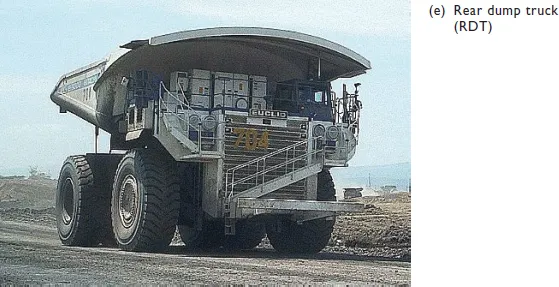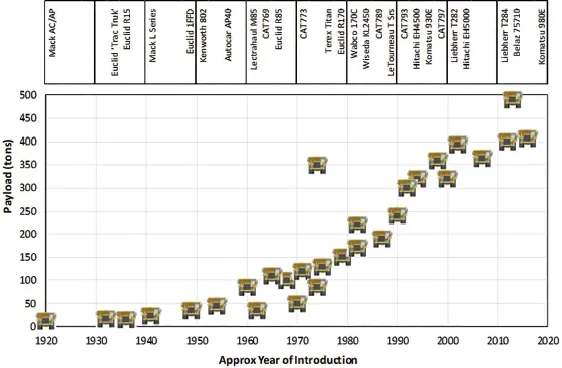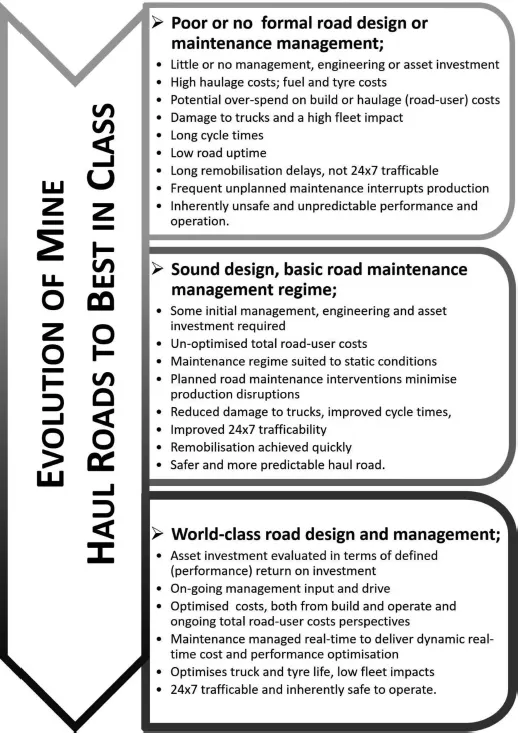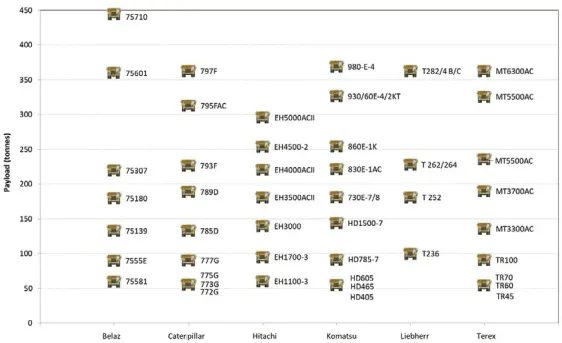![]()
Chapter 1
Introduction to mine haul roads
1.1 Importance of mine haul roads
Mining operations may be classified into surface mining, where the operations are unconstrained and open to the sky, and underground operations, where mining takes place in tunnels and galleries. In both situations roads play a key role as a typical mining operation consists of moving overburden (waste material) and ore from where the material was formed or deposited, to waste dumps or beneficiation plants. In surface mining, material movements are typically made by vehicles ranging from conventional on-highway trucks, road-trains (tractor-trailer combinations) and special purpose off the road (OTR) or off-highway dump trucks as shown in Figure 1.1; the current largest being over 600 t gross vehicle mass (GVM). In contrast, underground operations material transportation takes place by load-haul-dump units, delivering to an ore or waste-pass system which then either feeds underground haul trucks (typically 40–80 t payloads), or a conveyor or shaft system which delivers the material to surface. In both cases, but more especially surface mining applications, the haul road plays a critical and central role in safe, efficient and cost-effective mining.
What comprises a mine haul road has various definitions, depending both on the class of vehicle using the road and the wheel and axle load limits of the road design itself. Three basic types of haul road can be defined, based on application and the specific type of trucks associated with it:
- Road legal:
- Sealed (paved) roads:
- Conventional truck and truck-semi-trailer combinations
- Single, double or triple trailer road trains, < 120 t capacity
- Unpaved roads, additionally:
- B-double, B-triple and Quad road trains (with powered trailer options), < 170 t capacity
- Off road (unpaved) and in-pit:
- Small scale operations and civil construction – articulated dump trucks (ADTs), < 75 t capacity
- Custom road trains with > 200 t haulage capacity
- Rear-dump trucks (RDTs) and bottom-dump trucks (BDTs)
Figure 1.1 Surface mining haulage options.
In the case of surface mining, economy of scale and the increase in haul truck payload, as shown in Figure 1.2, have so far seen the RDT ultra-class truck (> 220 t payload, > 380 t GVM) population rise significantly (Gilewicz, 2006). With this increasing size, haul road performance can be compromised, resulting in excessive total road-user costs; often seen directly as an increase in cost per ton hauled, but also indirectly as reduced production rates and vehicle and component service life. Especially with the larger haul trucks now predominant in surface mining, it is advantageous to consider the haul road as an asset, similar to the vehicles that use the road.
Consequently, the road design and its performance and maintenance management processes should be integrated with the process of mine haulage systems management. Figure 1.3 illustrates the evolution of haul road design and management in terms of an evolving asset management system.
In the early 2000s, the concept of autonomous trucking (driverless RDTs) has moved from prototypes to production-ready applications. In this scenario, the operating performance of the haul road will become ‘mission critical’ to the overall success of autonomy in mining. Rapid deterioration of haul roads will require costly remediation, human intervention and significant, albeit temporary, changes to operating procedures, to accommodate these types of events. With autonomous trucking, vehicle path wander is minimal and the road will be subject to high channelised wheel loads over a limited area, without the wheel-path variations often encountered with conventional trucking.
Many concepts from highway engineering can be adapted to the design, construction and management of mine roads. However, significant differences in applied loads, traffic volumes, construction material quality and availability, together with design life and road-user cost considerations, indicate that a custom-made design solution is required. Under-performance of a haul road will impact immediately on operational safety and cost-efficiency, since up to 50% of the total costs of surface mining can be ascribed to haulage costs and mining is dependent on well-designed, constructed and maintained haul roads (Thompson and Visser, 1999). Most mine operators will agree that a strong relationship exists between well-constructed and maintained roads and safe, efficient mining operations. However, mining roads are often seen as ‘non-core’ components of the mining process and, as a result, mining operations may not give due or targeted consideration to appropriate road design standards, construction, operational and maintenance management issues (Kecojevic et al., 2007).
Figure 1.2 Trend in truck payload capacity for selected rear dump truck models from 1920s onwards.
Where design standards and operational management input is lacking and an empirical design approach used, safe, economically optimal roads eventually result – but the learning curve is steep, slow and inherently costly and hazardous. This approach does not lend itself to an understanding of the road design process and more importantly, if haul road performance or safety is sub-standard, identifying the underlying cause of the unsafe condition and/or design deficiencies which contribute to poor performance or an accident (as a root-cause or associated factor), is problematic. An ad-hoc or empirical approach to haul road design is generally unsatisfactory because it has the potential for over-expenditure, both on construction and operating costs, arising due to the following:
- over-design and specification, especially in the case of short-term, low-volume roads where the effect of rolling resistance, although minimised, does not contribute significantly to reducing total road-user costs across the mine’s network of roads due to the higher initial construction cost; or
Figure 1.3 Evolution in mine road design and management.
- under-expenditure on road design and construction, leading to premature failure; excessive truck operating costs; loss of productivity and, in the case of longer-term, high-volume roads, high contributory costs from rolling resistance effects. Under-designed roads are often maintenance intensive, to the extent that even well-built roads appear to perform poorly, due to maintenance being postponed on these roads to accommodate the intensive conservation requirements of the under-designed roads.
As tonnage increases and larger haul trucks are deployed, not only would the maintenance costs of existing roads of inadequate design increase, vehicle operating and maintenance costs also increase prohibitively. Formalising the approach to mine haul road design enables mining operations to benefit fully from the following:
- a safe, world-class road for all road-users;
- lowest vehicle operating costs, as a result of good haul road quality leading to faster cycle times and thus higher productivity and lower cost per ton;
- less stress on drive train, tyres, frame and suspension resulting in higher asset utilisation (less downtime) and component life; and
- optimum performance at minimum cost per ton hauled for the truck fleet and lower capital investment.
For these requirements to be fully and cost-effectively met, the approach to mine road design needs to consider and accommodate the range of haul trucks available to various types and sizes of mining operations. Figure 1.4 shows the range of available rear dump truck payload capacities (in metric tonnes) available from the major suppliers of Belaz, Caterpillar, Hitachi, Komatsu, Liebherr and Terex.
Figure 1.4 Range of payload capacities available for OTR rear dump mine trucks.
Following from the potential benefits, it is evident that there is considerable truth in the statement “haul roads can be profitable if properly designed but can cost you dearly if not carefully designed”. However, direct financial benefits extend well beyond profitability and dividends, contributing also to the broader issues of sustainable development (SD). Contributions to a sustainable mining industry that can be derived from focusing on the mine haulage component of the mining cycle are critical and central to many SD reporting strategies. Typical SD reports encompass specific targets relating to energy and water consumption, greenhouse gas (GHG) emissions and safety and innovation. Improvements in haul road design and management can contribute positively to long-term sustainability solutions, in a relatively short-term implementation timeframe. Short-term value can clearly be derived from reduced energy, water and safety-hazards associated with mine haulage, whilst any costs associated with GHG emissions levied in the future also leverage longer-term benefits.
1.2 Characteristics of mine haul roads
Historically haul roads were unengineered, using the in-situ material as both the road structure and wearing course. Since the in-situ material did not necessarily have the support nor provide a safe and all-season use – especially in areas of deep weathering or regolith, the performance of these materials as a haul road were often unpredictable and unsatisfactory, both from a safety and economic perspective.
One of the first, and arguably most important, initiatives to formalise the approach to design and management of mine haul roads was the USBM Information Circular 8758 – Design of Surface Mine Haulage Roads – A Manual, by Kaufman and Ault (1977). The aim of this publication was to provide a broad manual of recommended practices that promote safer, more efficient haulage. The authors recognised that the development of surface mine haulage equipment had outstripped available (mine) road design technology, resulting in numerous accidents caused by road conditions that were beyond the vehicle’s and driver’s ability to negotiate safely.
The content of the USBM design guidelines was developed primarily in response to haulage accidents, but also included current (1970s) practice information from mining companies and equipment manufacturers. Content covered such aspects as road alignment (both vertical and horizontal), road cross-section, construction materials, surfacing materials, road width, cross-slope and berm design, together with traffic control and drainage provisions, as was suggested criteria for road and vehicle maintenance and for runaway vehicle safety provisions.
The USBM Guidelines adopted structural (layerworks) design procedures following the CBR thickness design procedure (Tannant and Regensburg, 2001; Thompson, 2011a; Yoder and Witczak, 1975, and discussed in Chapter 3 of this book), but based on the comparatively small haul trucks that were operated in the 1970s. Recent research by Thompson and Visser (1996) applied mechanistic analysis procedures which showed that the CBR method does not necessarily give the most effective road structural composition, especially as larger wheel loads, typical of today’s ultra-class haul trucks, are now more commonly used.
Haul roads, particularly in surface mines, have generally been unpaved, which means that natural materials such as soil or gravel have been used as a wearing surface. The rationale for using untreated material, in addition to cost and performance considerations, was that, often, large rocks would spill onto the road and, on an unpaved wearing course, the material could be easily removed with motor-grader or front-end loader without permanent damage to the road. This policy has consequently been adopted by most surface mines.
However, with a dust-free road having become a requirement from a safety and environmental perspective, semi-permanen...




 Figure 1.3 Evolution in mine road design and management.
Figure 1.3 Evolution in mine road design and management.